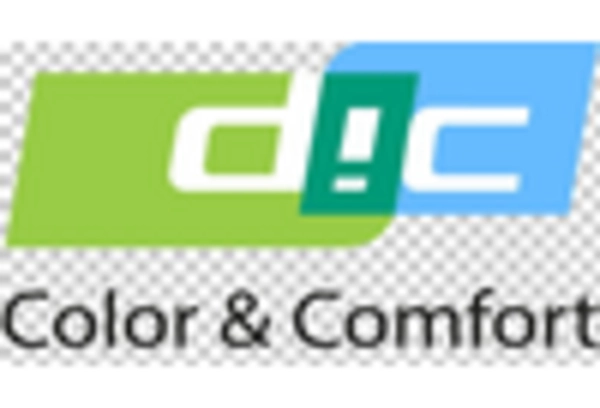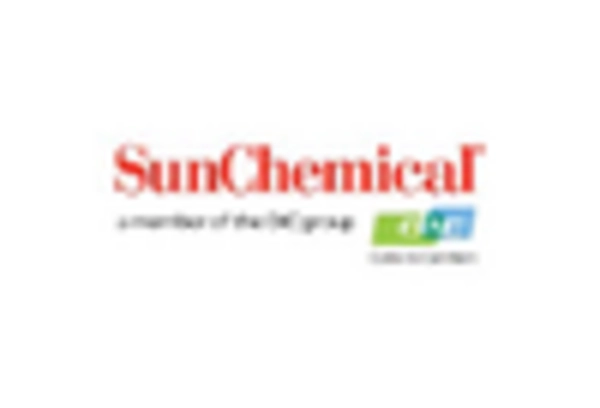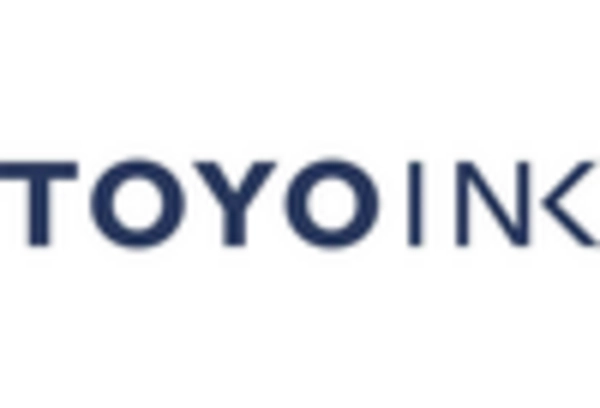Consumer Preferences
Consumer preferences are significantly shaping the Water-Based Ink Market. As awareness of environmental issues grows, consumers are actively seeking products that align with their values, including sustainability and safety. Water-based inks, known for their non-toxic and eco-friendly properties, are increasingly preferred in various applications, from packaging to textiles. In 2025, it is projected that consumer demand for sustainable inks will drive a 6% increase in the water-based ink market. This shift in consumer behavior is prompting manufacturers to innovate and develop new formulations that cater to these preferences. Additionally, brands that utilize water-based inks in their products often experience enhanced customer loyalty and brand image, as consumers are more likely to support companies that prioritize environmental responsibility. This trend underscores the importance of aligning product offerings with consumer values in the water-based ink market.
Sustainability Focus
The increasing emphasis on sustainability is a pivotal driver for the Water-Based Ink Market. As consumers and businesses alike become more environmentally conscious, the demand for eco-friendly products rises. Water-based inks, which are less harmful to the environment compared to solvent-based alternatives, are gaining traction. In 2023, the market for water-based inks was valued at approximately 3 billion USD, with projections indicating a compound annual growth rate of around 5% through 2030. This shift towards sustainable practices not only aligns with regulatory requirements but also enhances brand reputation, making water-based inks a preferred choice for manufacturers aiming to reduce their carbon footprint. Companies are increasingly adopting water-based inks in various applications, including packaging and printing, to meet consumer expectations for sustainable products.
Regulatory Compliance
Regulatory compliance is an essential driver influencing the Water-Based Ink Market. Governments worldwide are implementing stringent regulations to limit the use of volatile organic compounds (VOCs) in inks and coatings. Water-based inks, which typically contain lower levels of VOCs, are becoming the preferred choice for manufacturers aiming to comply with these regulations. In 2023, the market saw a notable increase in demand for water-based inks due to new legislation aimed at reducing environmental pollution. This regulatory landscape is expected to continue evolving, with more countries adopting similar measures. As a result, manufacturers are increasingly investing in water-based ink technologies to ensure compliance and maintain competitiveness in the market. The ability to meet regulatory standards not only enhances product appeal but also opens up new market opportunities for water-based ink producers.
Rising Demand in Packaging
The rising demand in the packaging sector is a significant driver for the Water-Based Ink Market. As e-commerce continues to expand, the need for sustainable and visually appealing packaging solutions has intensified. Water-based inks are increasingly favored for their ability to provide vibrant colors and excellent adhesion on various packaging materials. In 2025, the packaging segment is expected to account for over 40% of the total water-based ink market share, reflecting a shift towards sustainable packaging solutions. This trend is further supported by regulatory pressures to reduce the use of harmful solvents in packaging materials. As brands seek to enhance their packaging aesthetics while adhering to environmental standards, the adoption of water-based inks is likely to increase, positioning them as a key player in the packaging industry.
Technological Advancements
Technological advancements play a crucial role in shaping the Water-Based Ink Market. Innovations in ink formulation and printing technology have led to improved performance characteristics of water-based inks, such as faster drying times and enhanced color vibrancy. The introduction of digital printing technologies has further propelled the adoption of water-based inks, as these inks are compatible with a wide range of substrates. In 2024, it is anticipated that the market will witness a surge in the use of water-based inks in digital printing applications, driven by the need for high-quality prints and reduced environmental impact. Furthermore, advancements in inkjet technology are enabling manufacturers to produce water-based inks that meet the stringent requirements of various industries, including textiles and packaging, thereby expanding their market reach.


















Leave a Comment